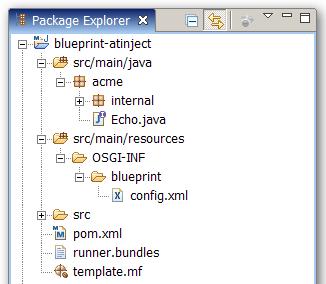Get ahead
VMware offers training and certification to turbo-charge your progress.
Learn moreLast month, almost 4 years after the initial 4.0 release, OSGi Alliance officially approved the OSGi service platform 4.2 release. The announcement headline featured the Blueprint Container Service, a new addition to the Compendium specification based on the programming model promoted by the Spring Dynamic Modules (also known as Spring OSGi) project. To quickly summarize Blueprint, I will just blatantly quote the OSGi spec:
(Blueprint Container) [...] defines a dependency injection framework, specifically for OSGi bundles, that understands the unique dynamic nature of services. It provides an OSGi bundle programming model with minimal implementation dependencies and virtually no accidental complexity in the Java code.
Users familiar with IoC concepts or Spring and Spring DM configuration, will find the Blueprint specification easy to grasp. In fact, being derived from Spring DM, many of the Blueprint concepts, syntax and terminology are identical and porting an existing an application between the two, in most cases, should be just a matter of adjusting the configuration files. In terms of features, Blueprint offers an inversion of control container that supports constructor and setter injection, factory methods, life cycle management and callbacks, signature disambiguation and type conversion among other things. On the OSGi side, one can use exporters and importers for transparent publication and consumption of OSGi services.
Below is a a code snippet from a Blueprint configuration that creates several objects, imports a service, wires them together then exposes the target as an OSGi service:
<?xml version="1.0" encoding="UTF-8"?>
<blueprint xmlns="http://www.osgi.org/xmlns/blueprint/v1.0.0" default-activation="lazy">
<!-- basic object creation -->
<bean id="object" class="java.lang.Object"/>
<bean id="length" class="java.lang.Integer">
<argument value="4"/>
</bean>
<bean id="buffer" class="java.lang.StringBuffer" depends-on="simple">
<property name="length" ref="length"/>
</bean>
<bean id="current-time" class="java.lang.System" factory-method="currentTimeMillis" scope="prototype"/>
<bean id="list" class="java.util.ArrayList" destroy-method="clear" activation="eager">
<argument ref="length"/>
</bean>
<!-- service import -->
<reference id="ds" class="javax.sql.DataSource" filter="(batch-size=200)"/>
<bean id="consumer" class="org.springframework.jdbc.core.simple.SimpleJdbcTemplate">
<property name="dataSource" ref="ds"/>
</bean>
<!-- service export -->
<service id="publisher" ref="consumer" auto-detect="interfaces"/>
</blueprint>
Besides the configuration, Blueprint also offers a small API (through container and reflect packages) for dependency lookup, reading meta data, or performing custom type conversion which resembles, to some degree, that of Spring. For more information on the similarities (and differences) between Blueprint and Spring DM, see the dedicated chapter in the DM 2.0 M1 reference documentation.
It is worth pointing out that while Blueprint depends on the OSGi 4.2 API, Spring DM 2.x does not. Users running OSGi 4.0 and 4.1 can safely use Spring DM 2.x; only the Blueprint functionality will be disabled, the rest of the features being available.
One of the key benefits of using Spring DM is having full access to the Spring container, transparently, from OSGi: whether you plan on using Blueprint, Spring /Spring DM API and configurations, Spring DM 2.x can accommodate both styles inside the same application thereby providing more flexibility. For example, field injection or annotation-based configurations can easily be added to a Blueprint bundle just as you would in a traditional Spring application, complementing the Blueprint functionality.
To wit, let's take one of the specification examples and combine the Blueprint configuration with JSR-250 (Common Annotations) and some of the new additions in Spring 3 such as the JSR-330 (Dependency Injection for Java) support.
public interface Echo {
public String echo(String m);
}
public class EchoImpl implements Echo {
String message;
public void setMessage(String m) {
this.message= m;
}
public String echo(String s) { return message + s; }
}
<blueprint>
<service id="echoService" interface="com.acme.Echo" ref="echo"/>
<bean id="echo" class="com.acme.EchoImpl"
<property name="message" value="Echo: "/>
</bean>
</blueprint>
I will be using Maven for this example and thus its conventions for the project layout:
[caption id="attachment_2939" align="aligncenter" width="326"] [/caption]
[/caption]
public class EchoImpl implements Echo {
@Inject
private PackageAdmin pkgAdmin;
String message;
public void setMessage(String m) {
this.message = m;
}
public String echo(String s) {
return message + s;
}
@PostConstruct
void startup() {
Bundle bnd = pkgAdmin.getBundle(getClass());
ExportedPackage pkg = pkgAdmin.getExportedPackage(Echo.class.getPackage().getName());
System.out.printf("Echo service bundle [%s] wired to bundles %s\n", bnd.getSymbolicName(),
Arrays.toString(pkg.getImportingBundles()));
}
}
<blueprint>
<service id="echoService" interface="com.acme.Echo" ref="echo" />
<bean id="echo" class="com.acme.internal.EchoImpl">
<property name="message" value="Echo: "/>
</bean>
<reference id="pkgAdmin"
interface="org.osgi.service.packageadmin.PackageAdmin" />
<context:annotation-config/>
</blueprint>
Excluded-Exports: *.internal*
Notice that the template contains no information regarding the annotations or the configuration - since 1.0.0.M6 Bundlor understands Blueprint bundles, it automatically picks up and parses any relevant configurations and classes.
# mvn package
And we're done. Now let's run our example.
Manifest-Version: 1.0
Export-Package: com.acme;version="0.0.0"
Bundle-Name: blueprint-atinject
Bundle-ManifestVersion: 2
Bundle-SymbolicName: blueprint-atinject
Import-Package: javax.annotation,javax.inject,org.osgi.framework,org.o
sgi.service.packageadmin
Simply deploy the resulting jar into an OSGi 4.2 framework alongside Spring DM 2.0.0.M1 and you should see the following output:
INFO: Blueprint API detected; enabling Blueprint Container functionality
...
INFO: JSR-330 'javax.inject.Inject' annotation found and supported for autowiring
...
Echo service bundle [blueprint-atinject] wired to bundles []
...
INFO: Publishing service under classes [{com.acme.Echo}]
Below is my OSGi bundle list (resulting from invoking ss in equinox):
0 ACTIVE org.eclipse.osgi_3.5.0.v20090520
1 ACTIVE com.springsource.slf4j.api_1.5.6
Fragments=2
2 RESOLVED com.springsource.slf4j.juli_1.5.6
Master=1
3 ACTIVE com.springsource.slf4j.org.apache.commons.logging_1.5.6
4 ACTIVE com.springsource.org.aopalliance_1.0.0
5 ACTIVE com.springsource.net.sf.cglib_2.1.3
6 ACTIVE org.springframework.asm_3.0.0.RC1
7 ACTIVE org.springframework.expression_3.0.0.RC1
8 ACTIVE org.springframework.core_3.0.0.RC1
9 ACTIVE org.springframework.beans_3.0.0.RC1
10 ACTIVE org.springframework.aop_3.0.0.RC1
11 ACTIVE org.springframework.context_3.0.0.RC1
12 ACTIVE org.springframework.osgi.io_2.0.0.M1
13 ACTIVE org.springframework.osgi.core_2.0.0.M1
14 ACTIVE org.springframework.osgi.extender_2.0.0.M1
15 ACTIVE com.springsource.javax.inject_0.9.0.PFD
16 ACTIVE com.springsource.javax.annotation_1.0.0
17 ACTIVE blueprint-atinject_0.0.0
You can find the project archive (with instructions) attached here.
By embracing de-facto standards (like dependency injection) inside the OSGi platform, we believe that Blueprint is beneficial to OSGi and non-OSGi developers alike, as it encourages API decoupling and externalization of infrastructure concerns, considerably lowering the entry barrier for creating and configuring OSGi applications.
We are quite excited about the road ahead and the features currently in development!
For more updates (and feedback!) on OSGi and Spring DM, follow us on this blog and on Twitter (through tags #osgi, #springdm, #dmserver. Yours truly is available at @costinl).